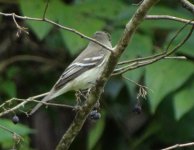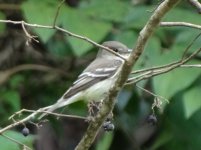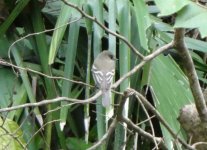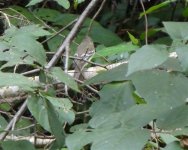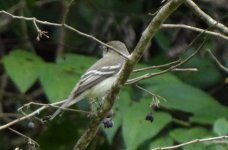SueO
Well-known member
I was torn as to where to post this: ID or Birds and Birding, but I think I will get more feedback here. It's a bit breathy though. I have copied from my new blog:
I have been thinking of splitting my blog, The Twitching Sailor, for some time and it’s ironic that when I finally do, my first post is going to be on a difficult bird and a difficult call as to whether I should have included it on my Life List. I have not put a bird on my list if I wasn’t 100% sure of what it was, until now. There is room for error here and I wonder if that margin should keep me from listing. I began this sailing adventure with virtually no birding skills or knowledge so I have seen my share of birds that I could not list. In fact, I may have the biggest ‘not listed’ bird list in the world! My birding skills have improved greatly over the eleven years I’ve been out on Peregrine, but I am constantly being challenged, and I still come across birds that take me some time to ID. Maybe that is part of the reason so many get obsessed with this hobby; it challenges us on many different levels.
Here is my current dilemma:
The bird is an Empidonax and I believe it is an Alder Flycatcher. In my copy of Ridgely’s , Birds of Panama, he lumps the Alder and Willow together under Traill’s because they are ‘essentially indistinguishable in the field’, although he does say that Alder is said to show more of an eye-ring than Willow. The eye-ring thing is one of the points I have used to validate listing. It doesn’t really show well in the pictures I post here, but I when I saw the bird again this morning (unfortunately, I couldn’t get photos during my 2.5 second and 1.0 second encounters), I saw it in light that allowed me to clearly see an eye-ring. I have gone back several times since the original sighting hoping it would vocalize, but I’ve heard nothing.
I should point out that I have ruled out Eastern wood-Pewee for several reasons. The primary projection doesn’t appear long enough. I have never seen this bird perch higher than a few feet off the ground. It hunts at near ground level, it does not sally out and return to the same perch, and it isn’t vocal. I have encountered Eastern Wood-Pewees here on several occasions and I am confident this is not a Pewee.
Another reason for my going with Alder is the San Lorenzo/Fort Sherman list I often refer to. The list is part of a comprehensive natural resource list of the San Lorenzo Protected Area compiled by Peter L. Weaver and Gerald P. Bauer for the US Forest Service. A note at the end of the bird list says the table was compiled by George R. Angehr and W. Douglas Robinson of the Smithsonian Tropical Research Institute. It lists Alder, but not Willow. I know the list is missing things—I’ve found a few myself--Pale-vented Thrush, White-throated Thrush and Variegated Flycatcher, but on the whole the list is a great and reliable source.
I will continue to visit the site in hopes of getting a sound, but the bird is a passing migrant and I don’t know how long he will be around.
Any opinions or advice?
Sue
I have been thinking of splitting my blog, The Twitching Sailor, for some time and it’s ironic that when I finally do, my first post is going to be on a difficult bird and a difficult call as to whether I should have included it on my Life List. I have not put a bird on my list if I wasn’t 100% sure of what it was, until now. There is room for error here and I wonder if that margin should keep me from listing. I began this sailing adventure with virtually no birding skills or knowledge so I have seen my share of birds that I could not list. In fact, I may have the biggest ‘not listed’ bird list in the world! My birding skills have improved greatly over the eleven years I’ve been out on Peregrine, but I am constantly being challenged, and I still come across birds that take me some time to ID. Maybe that is part of the reason so many get obsessed with this hobby; it challenges us on many different levels.
Here is my current dilemma:
The bird is an Empidonax and I believe it is an Alder Flycatcher. In my copy of Ridgely’s , Birds of Panama, he lumps the Alder and Willow together under Traill’s because they are ‘essentially indistinguishable in the field’, although he does say that Alder is said to show more of an eye-ring than Willow. The eye-ring thing is one of the points I have used to validate listing. It doesn’t really show well in the pictures I post here, but I when I saw the bird again this morning (unfortunately, I couldn’t get photos during my 2.5 second and 1.0 second encounters), I saw it in light that allowed me to clearly see an eye-ring. I have gone back several times since the original sighting hoping it would vocalize, but I’ve heard nothing.
I should point out that I have ruled out Eastern wood-Pewee for several reasons. The primary projection doesn’t appear long enough. I have never seen this bird perch higher than a few feet off the ground. It hunts at near ground level, it does not sally out and return to the same perch, and it isn’t vocal. I have encountered Eastern Wood-Pewees here on several occasions and I am confident this is not a Pewee.
Another reason for my going with Alder is the San Lorenzo/Fort Sherman list I often refer to. The list is part of a comprehensive natural resource list of the San Lorenzo Protected Area compiled by Peter L. Weaver and Gerald P. Bauer for the US Forest Service. A note at the end of the bird list says the table was compiled by George R. Angehr and W. Douglas Robinson of the Smithsonian Tropical Research Institute. It lists Alder, but not Willow. I know the list is missing things—I’ve found a few myself--Pale-vented Thrush, White-throated Thrush and Variegated Flycatcher, but on the whole the list is a great and reliable source.
I will continue to visit the site in hopes of getting a sound, but the bird is a passing migrant and I don’t know how long he will be around.
Any opinions or advice?
Sue




